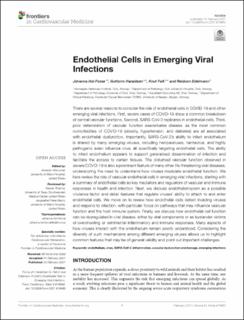| dc.contributor.author | Hol, Johanna | |
| dc.contributor.author | Haraldsen, Guttorm | |
| dc.contributor.author | Falk, Knut | |
| dc.contributor.author | Edelmann, Reidunn Jetne | |
| dc.date.accessioned | 2021-09-03T11:32:08Z | |
| dc.date.available | 2021-09-03T11:32:08Z | |
| dc.date.created | 2021-09-01T10:13:50Z | |
| dc.date.issued | 2021-02-24 | |
| dc.identifier.issn | 2297-055X | |
| dc.identifier.uri | https://hdl.handle.net/11250/2772857 | |
| dc.description.abstract | There are several reasons to consider the role of endothelial cells in COVID-19 and other emerging viral infections. First, severe cases of COVID-19 show a common breakdown of central vascular functions. Second, SARS-CoV-2 replicates in endothelial cells. Third, prior deterioration of vascular function exacerbates disease, as the most common comorbidities of COVID-19 (obesity, hypertension, and diabetes) are all associated with endothelial dysfunction. Importantly, SARS-CoV-2's ability to infect endothelium is shared by many emerging viruses, including henipaviruses, hantavirus, and highly pathogenic avian influenza virus, all specifically targeting endothelial cells. The ability to infect endothelium appears to support generalised dissemination of infection and facilitate the access to certain tissues. The disturbed vascular function observed in severe COVID-19 is also a prominent feature of many other life-threatening viral diseases, underscoring the need to understand how viruses modulate endothelial function. We here review the role of vascular endothelial cells in emerging viral infections, starting with a summary of endothelial cells as key mediators and regulators of vascular and immune responses in health and infection. Next, we discuss endotheliotropism as a possible virulence factor and detail features that regulate viruses' ability to attach to and enter endothelial cells. We move on to review how endothelial cells detect invading viruses and respond to infection, with particular focus on pathways that may influence vascular function and the host immune system. Finally, we discuss how endothelial cell function can be dysregulated in viral disease, either by viral components or as bystander victims of overshooting or detrimental inflammatory and immune responses. Many aspects of how viruses interact with the endothelium remain poorly understood. Considering the diversity of such mechanisms among different emerging viruses allows us to highlight common features that may be of general validity and point out important challenges. | en_US |
| dc.language.iso | eng | en_US |
| dc.publisher | Frontiers | en_US |
| dc.rights | Navngivelse 4.0 Internasjonal | * |
| dc.rights.uri | http://creativecommons.org/licenses/by/4.0/deed.no | * |
| dc.title | Endothelial cells in emerging viral infections | en_US |
| dc.type | Journal article | en_US |
| dc.type | Peer reviewed | en_US |
| dc.description.version | publishedVersion | en_US |
| dc.rights.holder | Copyright the authors 2021 | en_US |
| dc.source.articlenumber | 619690 | en_US |
| cristin.ispublished | true | |
| cristin.fulltext | original | |
| cristin.qualitycode | 1 | |
| dc.identifier.doi | 10.3389/fcvm.2021.619690 | |
| dc.identifier.cristin | 1930338 | |
| dc.source.journal | Frontiers in Cardiovascular Medicine | en_US |
| dc.relation.project | Norges forskningsråd: 302191 | en_US |
| dc.relation.project | Norges forskningsråd: 223250 | en_US |
| dc.identifier.citation | Frontiers in Cardiovascular Medicine. 2021, 8, 619690. | en_US |
| dc.source.volume | 8 | en_US |

